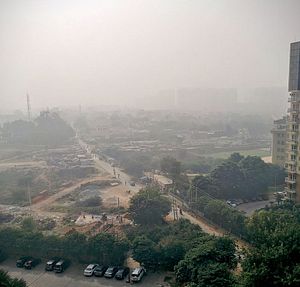For at least two consecutive years now, Delhi has briefly gained notoriety as the world’s most polluted city owing to its coal-based power plants, massive construction industry, and an estimated ten million vehicles on its roads. The air pollution gets exacerbated around the onset of winter because farmers in north India burn crop stubble in order to prepare the ground for a new sowing cycle.
This year, the burning of firecrackers during the Diwali festival also caused an overnight spike in pollution. All major air pollutants (including particulate matter, ozone, nitrogen dioxide, and carbon monoxide) breached their prescribed maximum safe limits. The worst of these, particulate matter 2.5 (PM2.5) – tiny cancer-causing particles less than 2.5 micrometers in diameter, which penetrate deep into the lungs – hovered around an unimaginable level of 999 microns per cubic meter, far exceeding the safe limit of 25 specified by the World Health Organization (WHO). Schools were shut and hospitals registered a sharp increase in patients with respiratory diseases. Dust particles even had an impact on vegetation by settling on leaves and interfering with photosynthesis.
Last year, the severity of the smog forced the Delhi government to introduce the innovative odd-even car scheme for a period of 15 days. Cars with an odd license plate number would ply the streets one day and those with an even number would take their turn the next day. But for all its success – it dramatically reduced traffic congestion – the scheme was unable to bring down pollution levels significantly.
Delhi is not an exception. Air pollution levels have increased manifold in several other cities across India. Allahabad, Lucknow, Patna, and Gwalior are now among the most polluted cities in the world. According to one WHO study, the injurious effects of air pollution – asthma, bronchitis, lung cancer, and even premature death – may have killed around 600,000 Indians in 2012. With coal production in India set to double by 2020, the situation appears slated to get worse.
While until recently air pollution was treated as a localized incident, climate change was rightly considered global is scope. Scientific studies now confirm that air quality has an effect on climate change and vice versa. Both feed on each other in an internecine cycle. Polluted air consists mainly of black carbon or soot, which is formed by incomplete combustion of fossil fuels, biofuels, and biomass. Black carbon is the primary component of PM2.5 and is the second major source of global warming after CO2. It is a short-lived climate pollutant (SLCP) responsible for nearly 50 percent of the global warming till date and has a warming impact on the climate 460-1,500 times stronger than CO2. It has accelerated the melting of glaciers in the Himalaya-Hindu Kush and Tibetan plateau. Black carbon is also shown to have an impact on extreme weather events such as intensified heat waves and cyclones and disrupted monsoon patterns, with consequent effects on health, livelihoods, food security, and the economy.
But SLCPs such as black carbon and its co-pollutants – ozone, methane, and hydrofluorocarbons – also have a silver lining. While CO2 emissions can remain in the atmosphere for hundreds of years, SLCPs remain in the atmosphere for a shorter duration, ranging from only a few days to a decade and a half. Therefore, reducing SLCPs can deliver immediate to near-term benefits. This is especially true for cities and towns, which tend to be densely populated. A decline in SLCP emissions will result in air quality improvement and public health. Millions of premature deaths can be prevented. Regional climate systems such as the monsoon rains will normalize and provide crucial time to adapt to climate change and prevent loss of livelihood. Replacing fossil fuel and biomass-based cooking and heating equipment with renewable energy-powered equipment will boost clean and green technology. The economic benefits of SLCP reduction, such as lower public health expenses, lower crop loss, and slowed climate destruction, will far outstrip its costs.
SLCPs are also one of the important areas of focus at the 22nd Conference of Parties of the United Nations Framework Convention on Climate Change in Marrakech, Morocco. The Climate and Clean Air Coalition, a group of governments, international organizations, civil society, and private sector advocates committed to reduction of SLCP emissions, convened a High Level Assembly in Marrakech on November 14 and released the Marrakech Communiqué, which calls on coalition members to take faster action on SLCP reduction.
Unlike long-term effects such as melting glaciers and rising sea levels, air pollution is an immediate and palpable driver and manifestation of anthropogenic climate change. Its ill effects on health are felt by the masses. It can prove to be an effective motivator for the public to bring lifestyle changes and compel the government to take steps to reduce SLCP emissions.
Zeenat Masoodi is a lawyer living in Srinagar, India and a COP 22 online fellow for Climate Tracker.
































